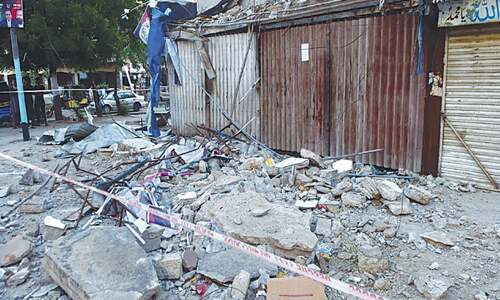
AMONG the many qualities of a great work of art, call it masterpiece, is its timelessness which basically stems from the fact that it is never one-dimensional. Mirza Asadullah Khan Ghalib is one top-notch Urdu poet who created countless couplets that are, to date, open to interpretation and yet from every contextual perspective sound extraordinary. The poet’s mantelpiece is chock-a-block with masterpieces.
Two cities seemed to have had a profound effect on Ghalib’s life: Delhi and Calcutta. If he had been to Karachi (for he passed away in 1869 when Karachi was developing as a clean, beautiful littoral town) he would have definitely taken a shine to it as well.
Come to think of it, if he had seen present-day Karachi, he would have written a number of ghazals, marked by elegiac quality, on its fast deteriorated state.
Ghalib penned an extremely moving couplet as part of one of his ghazals. It is:
Ab main hun aur maatam-i-yak shehr-i-aarzu Tora jo tu ne aaena, timsaal daar tha (Now I mourn the demise of the dream city of yore That broken mirror had allegories and fables galore)
Apart from the delightful architectural motifs and designs, Karachi’s old buildings had symbols on them. They stood for religious, political and national characters. The reason for it was that buildings in those days were not just roof-over-head facilities for the people. They were much more than that. They signified who they were, their aesthetic sense, and their desire for making their abodes not a transient resource but a permanent, or long-lasting, feature of their lives. Why? Well, they were aware of how ruthless the future can be.
There are three or four buildings on M.A. Jinnah Road, just before the Jama Cloth Market (if you are headed towards Merewether Tower) to which Ghalib’s above-mentioned two lines apply. If you cross the Burnes Road intersection to hit M.A. Jinnah Road (formerly Bunder Road), a big structure called Sugan Mansion with some sculpted figures on its top (perhaps mentioned on these pages some time back) in the right corner is one of them. The other is its next-door neighbour, as it were, and is one peculiar sight. It is known as Sitaram Building. By the way, the strip which connects the Burnes Road intersection to Bunder Road is Mohammad Bin Qasim Road.
Let’s talk about Sitaram Building first. (That’s the name of the oldie that a shopkeeper will tell you. Do not be sure though.)
Sitaram Building looks like a structure shattered, not demolished, by some kind of bloody battle. It is terribly fractured.
The huge openings and holes instead of windows make it come across as a semi-haunted place, which it is not. But, my word, the building is an elaborately beautiful work of art.
The carvings on its façade and the sturdy pilasters, in spite of the apparent ungainliness, speak volumes for the hard work and creativity that had gone into its making.
The ground floor is the mainly functional storey of the building, primarily because of a variety of shops. Striking up a conversation with the salesmen will reveal that they do not care much about it. Understandably so.
Moving back from this piece of art, you will see a modern building and then another old gem. If you feel flummoxed as to what these beauties are called, there is no solution to it. It is only fate which can, in this day and age, reveal their true identity.
Further back, you can thank your lucky stars because now you will have a clue (only a clue) to the genesis of this series of constructions. A small building has a plaque on its top which reads: ‘Wadhumal Deumal Panchayat Trust Buildings’.
So, there must have been a link, a connection of sorts, to all of them. Let’s praise the panchayat for giving us, in whichever way, such architectural beauties.
And yes, another piece of stonemasonry across Sitaram Building, perhaps built in more or less the same time period, can be best appreciated from its sidewall visible only from a narrow lane because its façade often gets shrouded in mist and haze not of history, but caused by the intractable vehicular traffic.
Architect Noman Ahmed says, “These buildings were part of market ventures. Businessmen used to reside in the upper stories and when their business expanded they would use the first floors as warehouses. With the passage of time these structure were used as large scale storage facilities. After partition when migrants came here and occupied these buildings they saw rooms full of goods.
“Till the 1930s buildings were made in an ornamented style. After that plain and straight facades came in vogue. Actually the traders wanted their designs to reflect their trade,” says Noman Ahmed.
Ghalib again comes to mind. This time with just one line: Meri tameer mein muzmir hai ik soorat kharabi ki (There is an inherent weakness in my composition)
mohammad.salman@dawn.com













































